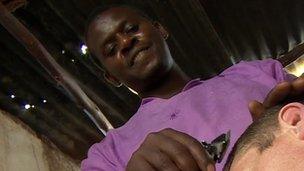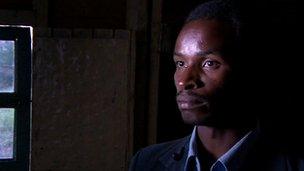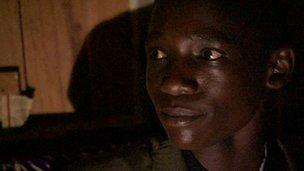Energy revolution promises to transform East Africa
- Published
Tom Heap reports for BBC Newsnight on how huge resources of geothermal steam beneath East Africa's Great Rift Valley are starting to be exploited.
An energy revolution is taking place in East Africa as the price of solar technology tumbles and huge resources of geothermal steam beneath the Great Rift Valley start to be exploited, moves which have the potential to lift millions out of poverty and cut greenhouse gas emissions.
It feels more like each strand of hair is being torn rather than cut, barber Sylvester Muthama explains as he demonstrates the manual clippers which he uses to cut hair in his salon in rural Kenya.

Without access to power Sylvester Muthama has to abandon his electrical clippers for manual ones
The problem, he tells me, is that the clippers tend to snag, especially with African hair, a worry for a barber who needs happy customers for his business to grow.
But Mr Muthama has little choice - the electric shears dangle uselessly to one side as this is not one of the very rare days when he has enough money to charge the car battery on the floor. And female clients must dry their hair in the sun.
His aunt, who shares the room to make clothes, must stitch by hand and power her iron with charcoal.
Mr Muthama's salon glorifies in the name Old Trafford Base and for him it is a Theatre of Dreams. He talks about how he would like to branch out, setting up a welding business. Yet in reality he is powerless:
"Without the electricity I am very much bored, for I have the ability but I have not the power," he says.
Step change
There are people like Mr Muthama all over Africa.
Closer to the city of Nairobi, I meet web designer Peter Njenga whose internet magazine owes its very existence to electricity, but who finds his ambitions thwarted by power surges which damage his computer and outages which prevent him from working.

Web designer Peter Njenga has lost vital computer equipment because of power surges
"I compare to the student who doesn't have a book or pen as electricity is what drives all our equipment right from the phones to internet connections to the computers. The younger generation… need reliable and very high quality power which is affordable," Mr Njenga says.
The power both he and Sylvester Muthama crave is right beneath their feet.
The Great Rift Valley is a tear in the Earth's crust stretching 3,000 miles (4,830 km) through Africa. In places the ground smokes and sulphurous fumes fill the air.
Drill down a couple of miles and, if your prospecting is good, you hit pools of water under great pressure and heated to 230C. Stick in a pipe and steam roars out ready for ducting into power stations to turn turbines and make electricity.
At Olkaria, near Lake Naivasha, in Kenya, they have been generating some electricity for 20 years, but now there is step change. With investment of around £1bn, in a few years they will be able to produce more electricity than the country's entire current average annual demand of 1,600 megawatts.
'The bright continent'
A little further north is Menengai Crater, where further test wells are being drilled and the potential could be even greater. Overall it is believed the geothermal potential in Kenya is 10,000 megawatts.

Wells drill down to pools of water under great pressure and superheated to 230C
Engineer Daniel Odongo, the man leading the hunt for the wells of superheated water, guides me up one of the rigs and talks with great pride about how he thinks his work could change Kenya:
"We need something that can put power online as fast as possible and geothermal is doing that for us… everyone now in Kenya is trying to find out what's going on in Olkaria, what's going on in the power sector, and we are having people coming from all over the world to see what we are doing here."
And the work does not stop at Kenya's borders - geothermal prospecting is happening in Ethiopia, Rwanda and Tanzania. Some of the money is coming from the African Development Bank and their regional director, Gabriel Negatu, says it could be transformative:
"Energy is not an end in itself; it is an enabler... every part of your life is affected by energy. [We'll see] a robust economy with factories, universities, a full industrial economy, and all of it will be powered by geothermal energy. What was once known as the Dark Continent will henceforth be known as the bright continent."
Spreading the word
But in remote villages of Africa, a quieter energy revolution is underway which could change lives more rapidly. Seven in 10 Africans are not on the mains grid, but wires and pylons are not the only way to deliver electricity.
Solar lights are now illuminating the homes of seven million Africans and sales are doubling every year.

In recent years solar technology has improved and the price plummeted
Harnessing the African sun has been considered before and foundered due to high cost and complexity. But in the last few years the price of technology has plummeted - solar panels, batteries and LED bulbs are now better and cheaper.
Also the need to charge millions of mobile phones has created an enormous appetite for relatively small amounts of power - the kind that solar can generate.
I join a company called Sunny Money in their Solar Roller - a minibus which carries the message of the benefits of solar power and the hardware needed to utilise it to remote villages.
In the Kenyan Highlands customers gather to see a demonstration of how the solar lights work - the majority are teachers interested in buying for themselves or parents buying the lamps for their children.
Many green ideas have been exposed as wishful thinking by the realities of life in Africa, so when the solar salesman throws his lamp on the ground three times, stamps on it and then reveals it still works the gasps are genuine.
Solar-powered schooling
At the nearby Kemba primary school the headmaster, Stanley Rugut says 600 of his pupils already have solar lights and he wants to help them buy more as they enable students to read in the evening, do more homework and get better results:

Student Enoch says he able to read for three extra hours a day thanks to his solar lamp
"Because of the light we have double the number going to good schools," he says. "At 700 Kenyan shillings (£5) a light is the same price as a hen."
In recent exams star pupil Enoch came 55th out of all of the students in Kenya. His ability to study improved considerably when his mother purchased a solar lamp.
"Before there was this light I used to read up until seven only, but when it was brought I read up to 10," Enoch, who hopes to one day be a doctor, explains.
It is about health too. Most homes in rural Africa are lit by paraffin lamps, and being exposed to an evening's lighting is thought to be as damaging to health as smoking 40 cigarettes.
The United Nations and many NGO's want to see them replaced by solar, and it now seems to be happening.
You can find out more about the revolution electrifying Africa in Tom Heap's reports on BBC Newsnight on Monday 25th February 2013 at 10.30pm on BBC Two and Costing the Earth on Radio Four on Tuesday 26th February 2013 at 3.30pm, repeated on Wednesday 27th February 2013 at 9pm.
Both programmes will also be available afterwards on the BBC iPlayer.
- Published4 December 2012